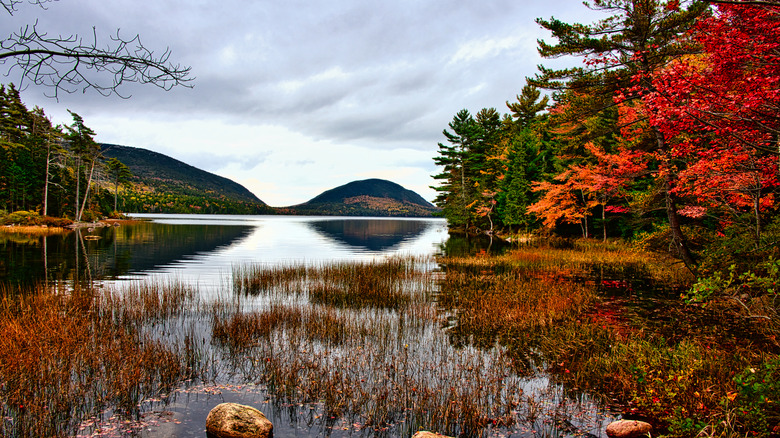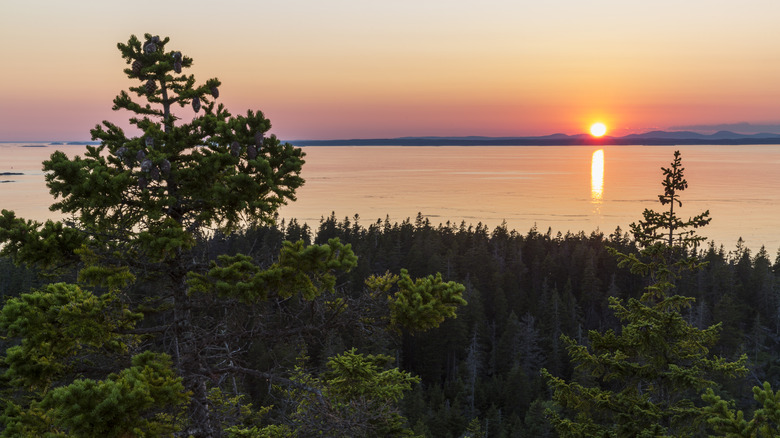The Best Ways To Avoid Acadia National Park Crowds
When you go to a place like Maine's Acadia National Park, you're probably hoping to have a quiet retreat into nature, seeing no one but your hiking companions and the natural wildlife that calls these coastal woods home. Unfortunately, a lot of other people have the same idea, and if you don't make a plan to avoid the crowds, you might find yourself fighting them for space on the trails. If you're willing to choose less well-known parts of the park, explore at odd hours, or visit during quieter times of year, however, you can still have a peaceful experience looking out at Acadia's misty shores.
If you want to enjoy the postcard-worthy scenery at Acadia National Park but aren't willing to brave the cold and rain of the off-season, you might have to get up pretty early in the morning or stay up late to avoid crowds. According to the National Park Service, the majority of traffic in Acadia happens between the hours of 8 a.m. and 5 p.m. If you're interested in a truly unique Acadia experience, consider staying at the park overnight, after most others have headed home. Then, you can see the waves hitting the moonlit shores or gaze up at the stars from usually popular spots in the park, like Jordan Pond, Sand Beach, or the summit of Cadillac Mountain.
Consider an autumn trip to Acadia National Park
Temperatures at Acadia National Park are often chilly, so most visitors appreciate the summer weather. In June, July, and August, temperatures are typically between 50 and 70 degrees Fahrenheit. While that might not make you want to throw on a bathing suit and head to the beach, it does make for perfect hiking conditions. However, if you want to avoid the hordes of travelers, you're probably going to want to pick another season for your trip to Acadia.
If you don't mind a muddy slog on the trails and are willing to dress appropriately for chilly mist, a spring visit might be right for you. Although temperatures can drop down into the 20s, by May, all the park's peak season services are open, and you might get to enjoy some sweater weather. If you love the snow and don't mind navigating closures, you can also come to Acadia in the winter when you're basically guaranteed a relatively private experience. For most, however, the best time to visit is in the fall.
In the fall, the park bursts into brilliant autumn colors, so as you explore the park, you can seek out the most beautiful hikes in Acadia National Park for staggering fall foliage. The state of Maine even runs MaineFoliage.com, a website you can use to find the best time to visit for peak colors. If you're worried about the weather, September and October can be a little cold, but they're still generally warmer than a spring visit.
Seek out lesser-known areas of the park to explore
Acadia National Park spans nearly 50,000 acres, so one of the easiest ways to avoid crowds there is simply by choosing less popular spots. For instance, Cadillac Mountain is a famously beautiful spot to watch the sunrise, but you may find a lot of other hikers watching it with you. The National Park Service suggests opting to watch the sunrise over the stunning pink granite cliffs of Ocean Drive Path Trail instead. Beautiful, beginner-friendly Jordan Pond Path is definitely worth a visit, but if you arrive at the trailhead and find the parking lot is full, you should have a backup plan in mind. Depending on when you arrive, you may also find the Sand Beach, Acadia Mountain, and Echo Lake parking lots packed, and there may be traffic along the Park Loop Road and the Eagle Lake Carriage Road Access.
Other areas of the park remain significantly quieter, however. The majority of Acadia is on Mount Desert Island, but you don't have to stay there to appreciate the park. One of the best regions of Acadia for avoiding crowds is the Schoodic Peninsula, where you can see the waves lapping at the shore and spot eagles soaring overhead. There are also numerous smaller islands within the park, like Isle au Haut, the most remote area in Acadia. You can only visit it by taking a very limited ferry from the mainland, which means there are almost no crowds at all. If you're up for the challenge of navigating its rocky shores and rugged trails, you can admire this incredible landscape with no one around but the shorebirds.


